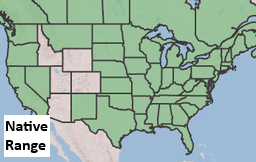Evening Primrose
Oenothera biennis
Click here to download a PDF of this plant information page (for printing).

Sun Exposure: Full Sun, Part Sun
Season of Interest: Summer, Fall
Bloom Time: June - September
Bloom Color: Yellow
Height: 3 to 5 ft.
Spread: 14 in.
Spacing: 16 in.
Water Needs: Average
Maintenance: None
Soil Type: Loam, Sandy, Clay, Rocky
Soil pH: Acidic, Neutral, Alkaline
Soil Drainage: Well drained
Pests: None
Diseases: None
Wildlife: Bees, Buterflies

Description:
: Evening primrose, a biennial plant native to North America, which bears large, light yellow bowl-shaped flowers, which open in the evening and attract pollinators, especially native bees that forage in the evening and night-flying pollinators such as moths. Historically evening primrose was used for medicinal purposes and is edible for both humans and other animals. In the garden, evening primrose releases a pleasant evening fragrance, and is a good wildlife plant.
Evening Primrose is typically found in recently disturbed soils, old fields, roadsides and other sunny medium to dry sites. It is one of the last natives blooming late into fall. As a biennial, it grows vegetatively during the first year, remains green through the winter, and completes its life cycle during the second year, but will re-seed. Much of the life cycle of the stunning pink Primrose Moth (Schinia florida) can be on the Evening Primrose plant. The small green larvae of the Primrose Moth will feed on the flowers and seed of the plant and the adult moth can often be found feeding on the yellow flowers. For more information see:
plants.ces.ncsu.edu/plants/oenothera-biennis
Care and Growing Tips:
Contrary to what you may have heard about a plant that only blooms in the evening (after 4PM) and night, evening primrose actually loves sunlight. It should be grown in a spot that gets full sunlight or partial shade. Another major requirement for growing evening primrose successfully is soil that boasts good drainage. That being said, the soil should still retain moisture, just not become water-logged. Consider adding a thick layer of mulch atop the soil to help keep the roots cool throughout the summer. Evening primrose can grow well even in rocky, sandy, clay, infertile soil.
Evening primrose is very drought tolerant so regular watering is unnecessary. Supplemental water is only needed in very dry conditions. While it blooms and grows best during late summer, evening primrose actually prefers to be cool rather than warm. The plant needs to get established with roots and foliage during the cooler months so it is best planted in the fall or early spring. Fertilizer is not a necessary addition to your evening primrose care regimen. It is known to actually bloom less when growing in very fertile soil.